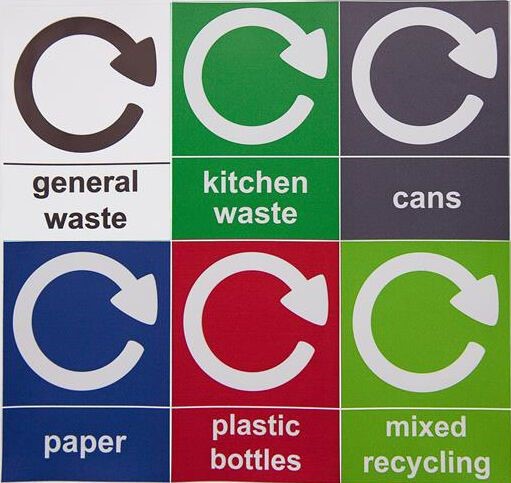
Comprehensive Recycling Bin Capacity Guide for Commercial Spaces: Volume Planning for Effective Waste Management
Selecting appropriate recycling bin capacities for commercial environments requires systematic analysis of waste generation patterns, ensuring sufficient volume for typical accumulation while optimizing service frequency and spatial efficiency. This detailed capacity planning guide examines the essential considerations when sizing recycling systems, helping commercial operations implement appropriate waste management infrastructure while avoiding common pitfalls of under or over-specification.
Understanding Capacity Measurements
Recycling bin capacity is typically expressed in litres (L) or occasionally in gallons (gal) for some imported products, representing the internal volume available for waste collection:
Common Capacity Reference Points:
- Desk-side bins: 10-20L (compact personal collection)
- Office central bins: 30-60L (departmental collection)
- Commercial collection stations: 60-120L (primary collection points)
- Large commercial containers: 120-240L (high-volume applications)
- Industrial collection units: 240L+ (production environments)
These volumes should be considered alongside typical waste generation patterns to determine appropriate capacity for specific commercial applications.
Capacity Calculation Methodology
Determining optimal recycling bin capacity involves evaluating multiple factors:
- Waste Generation Assessment: Analyse your commercial operation's waste production patterns:
- Document the volume of each recyclable material generated daily
- Measure in litres or kg depending on available data
- Note variations between different areas or departments
- Identify peak generation periods (seasonal, weekly, or daily)
- Consider future growth or operational changes affecting volumes
- Account for any waste reduction initiatives being implemented
- Gather data through waste audits if accurate information unavailable
- Service Frequency Determination: Establish realistic collection schedules based on operational factors:
- Standard cleaning staff routing and availability
- Weekend or holiday periods without regular service
- Practical limitations on collection frequency
- Cost implications of more frequent servicing
- Odor or hygiene concerns limiting maximum intervals
- Security or confidentiality requirements affecting timing
- External waste contractor collection schedules
- Capacity Calculation Formula: A basic formula for determining appropriate recycling bin capacity:
Required Capacity (L) = Daily Waste Volume (L) × Maximum Days Between Collections × Peak Factor (1.2-1.5)
The Peak Factor represents a buffer accommodating unusually high generation periods, with 1.2 suitable for consistent commercial operations and 1.5 appropriate for highly variable environments.
Commercial Space-Specific Capacity Guidelines
Different commercial environments have distinct waste profiles affecting capacity requirements:
Office Environments:
- Individual workstations: 10-15L per employee (paper/general waste)
- Print/copy areas: 50-80L per 20-30 employees (predominantly paper)
- Office kitchens: 30-60L per 20 employees (packaging/food waste)
- Meeting rooms: 15-30L depending on room capacity and usage
- Reception areas: 30-50L with emphasis on appearance and discretion
- General office recycling stations: 60-80L per 20-30 employees
Adjustment factors:
- Paper-intensive operations: Increase paper recycling by 25-30%
- Digital-focused businesses: Reduce paper capacity by 20-25%
- Food service availability: Increase food waste capacity accordingly
- Hot-desking environments: Centralize rather than providing personal bins
- Extended operating hours: Increase capacity or service frequency
Retail Commercial Spaces:
- Sales floor recycling: 60-100L per 100m² of floor space
- Back-of-house areas: 80-120L per 10 employees
- Payment points: 30-50L for packaging and paper
- Product unpacking areas: 120-240L focusing on cardboard
- Customer service points: 30-60L for paperwork and packaging
- Food retail specific: Additional capacity for organic waste
Adjustment factors:
- High product turnover: Increase packaging recycling by 30-40%
- Seasonal variations: Plan for peak periods with 30-50% increased capacity
- Extended hours: Increase capacity or service frequency proportionally
- Self-service operations: Adjust for customer-generated waste patterns
- Luxury retail: Emphasize discretion and aesthetic integration
Hospitality Commercial Environments:
- Dining areas: 80-120L per 50 covers (predominantly packaging/food)
- Bar areas: 60-100L with emphasis on glass and packaging
- Kitchen operations: 100-240L with significant food waste provisions
- Hotel rooms: Centralized collection rather than in-room recycling
- Conference facilities: 30-60L per 50 delegates
- Reception/lobby areas: 60-80L with premium appearance
Adjustment factors:
- High beverage service: Increase glass/can recycling significantly
- Fine dining: Lower volume but specialized stream separation
- Buffet service: Increase food waste capacity by 40-50%
- Extended hours: Adjust for late night or 24-hour operations
- Seasonal business: Plan for peak capacity during high occupancy
Stream-Specific Capacity Distribution
Within total capacity requirements, distribution between waste streams should reflect typical commercial generation patterns:
Office Environments (typical distribution):
- Paper/Cardboard: 40-50% of total capacity
- Mixed Recycling (plastic, cans): 20-30% of total capacity
- Food/Organic Waste: 10-20% of total capacity
- General Waste: 20-30% of total capacity
Retail Environments (typical distribution):
- Cardboard/Packaging: 50-60% of total capacity
- Mixed Recycling: 15-25% of total capacity
- Food/Organic (if applicable): 10-15% of total capacity
- General Waste: 15-25% of total capacity
Hospitality Environments (typical distribution):
- Food/Organic Waste: 30-40% of total capacity
- Glass Recycling: 20-30% of total capacity
- Mixed Packaging: 15-25% of total capacity
- General Waste: 15-25% of total capacity
These distributions should be adjusted based on specific operational characteristics and waste audits when available.
Capacity Optimization Strategies
Several approaches can optimize recycling capacity in commercial spaces:
- Compaction Solutions:
- Manual compaction for paper and cardboard
- Built-in compaction mechanisms for high-volume materials
- Segregated collection allowing material-specific compression
- Specialized compactors for specific commercial waste streams
- Strategic Placement Optimization:
- Positioning larger capacity near high-generation points
- Implementing cascading capacity with distance from source
- Creating primary and secondary collection hierarchies
- Designing capacity distribution matching traffic patterns
- Visual Fill Level Indicators:
- Clear containers showing current fill status
- Fill-level indicators on opaque containers
- Service-required notification systems
- QR-triggered service request capabilities
Hall-Fast's waste management specialists can provide personalized capacity recommendations based on your specific commercial environment, waste profile, and operational characteristics. Our consultative approach ensures your recycling system provides appropriate capacity while optimizing spatial efficiency and service requirements.
Explore our complete recycling bin range online to view detailed capacity specifications and commercial-specific solutions. Our experts can provide guidance in selecting the optimal capacity configuration for your unique commercial environment.












